About a year ago I had someone coming to visit me from away and the only way I had of getting in touch with them was through Facebook.
Which meant that I was exposed to Facebook again for the first time in several years.
And so I decided to pay attention for a while: I was interested to see if, despite misgivings about its status as a sort Compuserve-like private Internet, there was value to be derived for the parts of my soul I was forced to give up.
I stuck with it for a year. I did, indeed, connect with some long-lost friends. And got some good letterpress advice from Sweden. I even set up an IFTTT recipe to automatically repost anything appearing on this blog as a new Facebook post, just to see what would happen, and when I shut off comments here Facebook became the de facto place for readers to leave comments. There certainly was some value to be had in the connections I made there, and in the continuous partial attention I was able to pay to a wide circle of family, friends and neighbours.
But, after a year, I’m bringing the experiment to a close. This will be my last post echoed to Facebook, and you shouldn’t expect to be able to reach me through Facebook’s communication tools any longer.
Which means that if you want to read what I write, you’ll need to come over to http://ruk.ca/ to do so, and if you want to reach me you’ll need to use one of the other myriad ways you’ll find laid out at http://ruk.ca/contact-peter-rukavina.
What’s ultimately responsible for disconnecting me from Facebook is simply being uncomfortable with contributing to the Facebook paradox: people join Facebook, and stay there, because everyone else, it seems, has a Facebook account. And so on. It’s where the baby pictures are. And the value proposition for many means that they’re willing to put up with the highly-targeted ads to see those baby pictures.
I’ve got nothing against the baby pictures, but I’ve decided that I can’t countenance continuing to engage with a system that is missing so many aspects of what makes free, open, non-Facebook Internet attractive.
And so, as much as I’m able, I’ll work on furthering that free, open, non-Facebook Internet, creating other less onerous homes for baby pictures.
It’s been an interesting year. I’ll see you all outside, I hope.
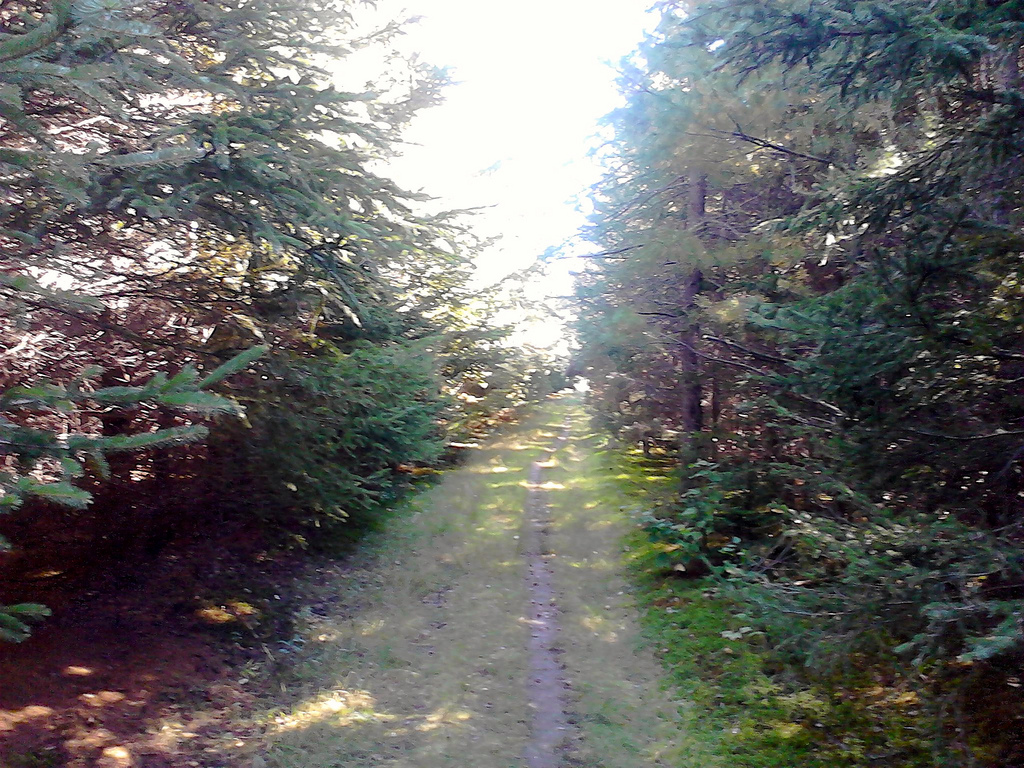
In an episode of corporate gymnastics that I don’t completely understand, CIBC sold part of its Aerogold Visa business to TD Canada Trust. I happened to be in the part of the business that was sold, and so in June of this year my CIBC Visa became a TD Visa (ironically I’d switched away from TD Visa several years ago to CIBC; they just keep pulling me back in again).
As part of the transition, I received a new Visa card number, and had to switch to using TD’s online systems. Because I’m a “pay my credit card balance every month, on time” kind of person, on the day I received my new TD Visa card, I immediately registered for a “TD EasyWeb” account for the card and turned on email statement notifications so I’d be sure not to miss my first statement.
And then life went on.
Until yesterday when I went to pay for something with my new TD Visa only to have it declined.
This morning I phoned TD to find out why and I was told that there was a “non-payment hold” put on my account because I hadn’t made a payment. I replied that I hadn’t received a statement yet, despite having set up email statement notification.
It was only at this point that I learned that, sometime after I set up a new EasyWeb account for the new credit card, TD, of its own volition, merged the new Visa card into my existing EasyWeb account, attached to a line of credit and a long-dormant chequing account. This old EasyWeb account didn’t have email notification turned on, which is why I never received a statement.
The agent claimed that the only way to make all of this right was to make a payment on the account, wait 3 to 5 business days for the payment to clear, then wait a further 2 business days for the hold to be removed.
In other words, I’d be without my business credit card for a week.
Despite my protests that this would be extremely inconvenient – not only would I not be able to purchase anything online for the business, but any automatic payments associated with the account would presumably be kicked back declined as well – I was told there was no way to override the system and that I was stuck.
I hung up.
I called back.
I explained the situation again, from the start, to a second agent.
The second agent told me he would immediately remove the hold, remove the $16 in interest that had accrued because of non-payment, and that I could start using the card again immediately.
So, TD, I’m not impressed.
And if you find yourself in the same situation you may want to both check to make sure you’re email statement notifications are turned on, and, if you find agent number one unhelpful, call back and speak to agent number two or three, who may have better answers.
In honour of our friend Ron Boyles, who died earlier this week, here’s a television ad, produced by my longtime friend and former business partner David Moses, that ran on the CBC in the mid 1990s. It was an ad most remarkable for the fact that despite having seen in dozens of times, it was only years later that I realized it was an ad for Boyles Optical, Ron’s family business.
To this day I have no idea whatsoever how David managed to convince Ron that producing a minute-long noir drama set in abandoned buildings down by the docks was exactly what his optical business needed. But he did. And it aired. And Ron had a story to tell for years after. It is, I think, the most interesting television commercial ever to air on the Island.
And that tells you a little something about Ron that might get lost in all the talk about his status as a gruff but legendary golfer. Which is not to say that Ron couldn’t be gruff or that he wasn’t legendary. But he was a complex man, not so easily summed up, and, despite being perhaps as far to the opposite end of almost any spectrum you can name from Ron, I always had a soft spot in my heart for him.
Thanks to Beryl and Jason at Moses Media for digging into the company video vault.
Ron’s funeral service will be held tomorrow, Friday, August 14, 2014, at 3:00 p.m. at Spring Park United Church in Charlottetown with visitation following until 6:00 p.m.
Our thoughts this week are with Carol and their children and grandchildren; Ron will be missed by many.
I’ve been doing some work this week on “geopresence archiving,” culminating in the release of some code, called GeoArchive, that will slurp in Foursquare, Plazes, Twitter, Openpaths, Google and Flickr geopresence data and convert it into GeoJSON.
GeoJSON is a funny thing: you’d think that the last thing the world would need is yet another format for GIS data. But it turns out that is exactly what the world needed, for GeoJSON appears to have hit a sweet spot of portability, understandability and flexibility that is causing a whole new set of geographical tools to flower.
Using the aforementioned GeoArchive, I converted every single geopresence I’d logged in the last 10 years (starting in 2004 with Plazes and continuing until the present) and dropped the resulting GeoJSON files into a GitHub repository called geotraces (yes, that’s making public some detailed private information, but it’s information about the past, and I haven’t murdered anyone or had an affair, so I’m comfortable with that).
I then used the (excellent, free, open) GitSpatial tool to sync that repository so that I could use its spatial querying magic to extract interesting insights from it.
I eat lunch at Tai Chi Gardens, a small vegetarian restaurant around the corner from my office, several times a week.
But exactly how often do I go there?
I decided to use my newfound geo-superpowers to find out.
I used the (dreamy) BoundingBox tool to get the coordinates for a bounding box around the restaurant, building in a comfortable buffer to allow for the inexactness of GPS:
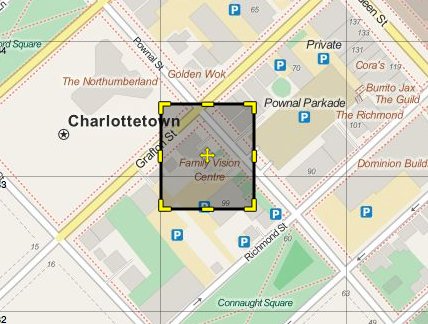
This gave me a bounding box (selecting the CSV format) of:
-63.1299796551,46.232755568,-63.1289904541,46.2335363014
To query my GeoJSON, I opted to start with my Google Latitude traces, which cover the longest recent period in the most detail (because, in part, they were collected passively; I didn’t need to “check in” to record my presence); the GitSpatial URL I ended up with was this one and visiting it gave me – handily and happily – some more GeoJSON, which I could feed to the (very helpful) GeoJSON.io, which allowed me to double-check that everything worked as I wanted (it did):
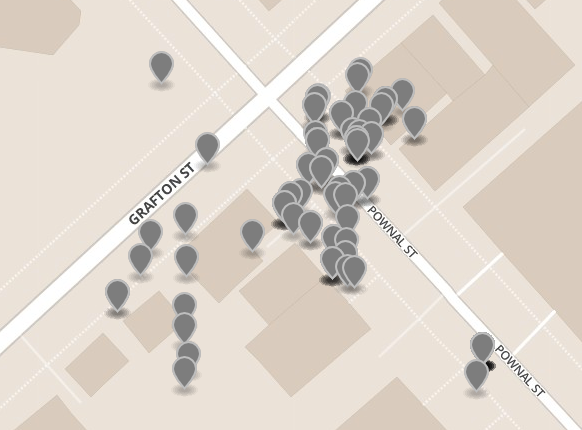
With this GeoJSON in-hand, I then used some old-school UNIX command line magic to extract the number of unique dates in that file:
grep when taichigardens.geojson | cut -d" " -f10 | cut -d'"' -f2 | sort | uniq
That gave me a list of dates when I’d been inside that bounding box – and, likely, eating lunch at Tai Chi Gardens:
2010-01-16 2010-02-20 2010-05-29 2010-06-15 2010-06-19 2010-06-26 2010-06-28 2010-10-16 2010-11-17 2010-11-20 2011-03-31 2011-04-05 2011-04-11 2011-04-20 2011-06-11 2011-06-13 2011-09-06 2011-09-27 2011-11-14 2011-11-23 2011-11-30 2011-12-12 2012-05-14 2012-05-15 2012-05-16 2012-05-18 2012-06-05 2012-06-06 2012-07-30 2012-08-01 2012-08-03 2012-08-06 2012-08-08 2012-08-10 2012-09-10 2012-09-17 2012-09-21 2012-10-31 2012-11-05 2012-11-13 2012-11-22 2012-11-26
Piping that result through wc and I find out that over the period from January 16, 2010 to November 26, 2012 I visited Tai Chi Gardens 42 times:
grep when taichigardens.geojson | cut -d" " -f10 | cut -d'"' -f2 | sort | uniq | wc -l
This is just a toe dipped in the water of the experimenting I hope to do with my decades-long stretch of geopresence data. I welcome you to join me.
While I was trawling through the archives of Arthur from 1985 this morning, I noticed that there was an ad in every issue for Ernie’s Barber Shop – “Ernie & Pauline, Operators” – on Simcoe Street:
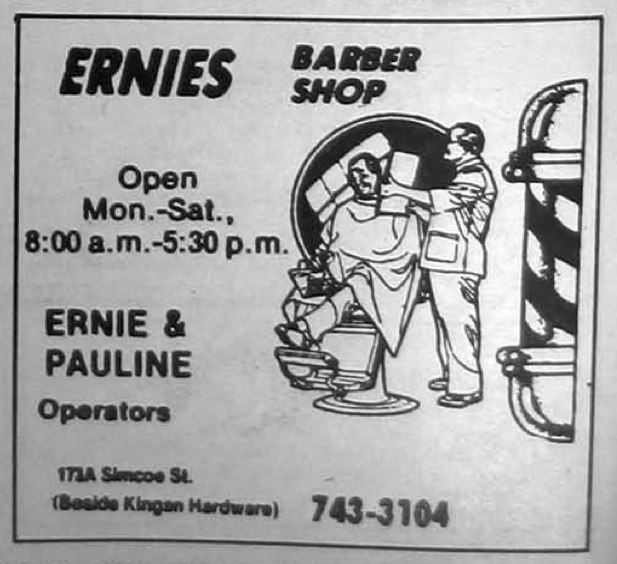
And then, in the issue of November 11, 1985, a review of Ernie’s that I wrote – my first newspaper story (although it ran, oddly, without a byline), headline “Real haircut”:
For the past 15 years, I’d been making the monthly trek out to the old “Long Acres Barber Shop” near home; Kurt, Louis, Joe and Mike were always there, always friendly and had become like members of the family. Moving away meant saying good bye to all that; facing the world on my own: finding a NEW barber.
I roamed the streets of Peterborough … oh there were places to get your hair cut — “Rice’s House of Unisex Hair Design,” “Fernando’s Hairateria”, “The Hair Cutting Ranch” — but no real barbers. In desperation. I let my fingers do the walking and pulled out the yellow pages. There. between “Dynasty Hair Design” and “Esquire Hair Salon” was what I’d been looking for “Ernie’s Barber Shop”.
Quickly I found my way to 173-1/2 Simcoe Street. At first I thought that Ernie’d been bought out by some crazed lawn ornament salesperson. There were all sorts of things — I think they call them “curios” — in the front window. It turned out that Ernie IS the crazed lawn ornament salesperson: I guess you can’t make a living just cutting hair.
I opened the door, walked in, and immediately knew I was in my element. I was greeted by Pauline (Ernie’s protege) and escorted to a real barber chair. Pauline was extremely friendly and my fears disappeared within minutes. The conversation was pleasant, my fellow customers interesting (there’s one lady who comes in nearly every day and has been for the past couple of decades) and the hair cut superb (I was assured that if I wasn’t pleased I could come in anytime and they’d touch it up “on the house”).
That article in Arthur caught the eye of James Ramsay, also an Arthur writer and a Trent student a few years my senior. James also grew up in near Aldershot, and also got his hair cut at the Long Acres Barber Shop. We remain friends to this day.
I had my cut for years thereafter at Ernie’s, sometimes by Ernie, and sometimes by Pauline (although after a while Pauline left and Ernie was on his own). Eventually the original location closed and Ernie opened up in a more modern space around the corner, and I followed him there. Who knows how many times Ernie cut my hair.
Toward the end of my time in Peterborough I went into Ernie’s for what turned out to be my last haircut in the the city and my last hair cut from Ernie. As I was sitting there in the chair with Ernie at work I noticed a newspaper clipped taped to the corner of the mirror: it was my article from Arthur.
I thought about telling Ernie that I was the writer – and for all know he’d figured it out — but I decided to remain anonymous. My haircut done, I paid Ernie, left him a tip, and headed out, a satisfied customer.
I learned this afternoon that Ernie died, of lung cancer, a couple of years ago; here’s his obituary
KALWA, Ernst “Ernie” Erwin, born 26 October 1929 in Osterode, Germany, succumbed to lung cancer in Peterborough on 01 December 2012. Ernie immigrated to Canada in 1953, and came to Peterborough on the recommendation of a man he met on the ship. He found work as an orderly at St Joseph’s Hospital where he met Registered Nurse Muriel Doris Calberry of Hastings. They were married 26th October 1955. He began barbering in 1954, operating Ernie’s Barber Shop on Hunter Street, and later on Simcoe Street, until retiring “a legend in barbering” in September 2012. Ernie was an avid angler and horse-racing enthusiast. He is survived by his loving wife Doris, son Paul Elliott Allen Kalwa of Peterborough, son Ernest Larry Kalwa (Elysia DeLaurentis) of Elora, sister Elli and brother Walter, both of Germany. He is predeceased by his parents Johann and Augusta Kalwa (née Opalka), brothers Adolf and Paul, and sisters Ida and Hedwig, all of Germany.
It amazes me to learn that Ernie was still barbering until two years ago, 27 years after I first walked in his door.
Thank you, Ernie, for filling an important void in my life at an important time. And for getting me started in the writing game.
Perhaps no institution was as important to my education in my twenties as Trent Radio, the campus-community radio station in Peterborough, Ontario.
My entrée to the station came via an ad in the October 7, 1985 issue of Arthur, the Trent University student newspaper:
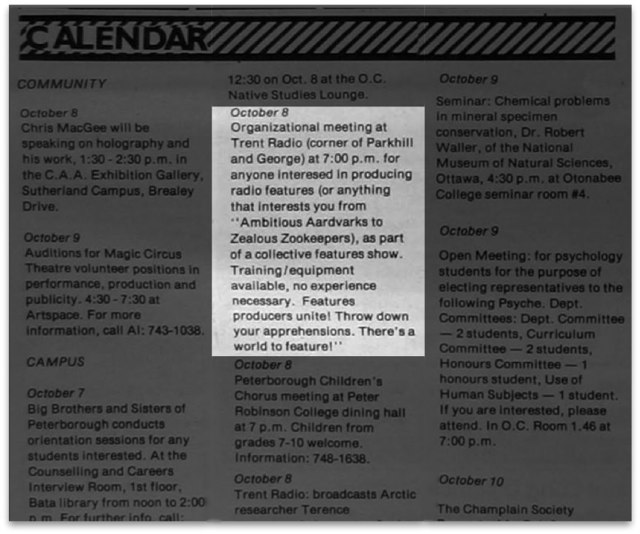
The meeting was well attended: among others there was Betsy Trumpener, Stephen Badhwar, Thomas Haig, and Jake Berkowitz. The product of that first meeting was a radio series we called “Nouspeak” and we were quick off the mark: in the very next issue of Arthur I had this update in the Letters section:
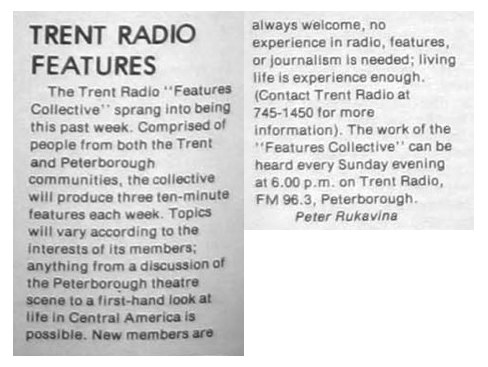
And by the November 11 issue of Arthur we were already running “best of” episodes:

My first piece aired on Thursday, November 21, 1985; titled “Phoning the Kremlin: Getting the Feel of a Global Village,” it consisted entirely of my attempt to phone somebody at the Kremlin in Moscow, a montage of various conversations with international telephone operators playing over Supertramp’s Fool’s Overture:

While I can’t make any claims to it having been great radio, it was an interesting experience, and I regret that there is no copy extant (my personal copy was stolen in a house break-in some years later).
I continued to be involved with Trent Radio for several years after that initial foray, producing music programs, an experimental unhosted call-in show called “Dead Air” (a tape loop ran over and over inviting callers to phone and “fill up the dead air”; as soon as they called, they went live to air with no intermediation), and a variety of other shows, both musical and spoken word. I worked as an “operator” (Trent Radio parlance for “the person who unlocks the doors and makes sure the producers show up), as the paid programme director. And I took on Trent Radio’s “producer oriented radio” mantra – wherein the emphasis is on radio production, not radio consumption – as a personal one, something that stays with me to this day.
Over the 5 years I spent in and around Trent Radio in various capacities I made good friends, fell in and out of love several times, and learned much, much more than I ever learned in the single year I spent as a student actually enrolled at Trent. It’s not an exaggeration to say that Trent Radio is where I grew up, and I owe the institution a great debt for that.
I was moved to write all this because today is the day that Trent Radio is celebrating Trent University’s 50th birthday; starting at 17:00 Eastern Daylight Time, you can listen in to the Trent Radio web stream and hear programming from producers-past. Here’s the broadcast schedule, liberated from Facebook:
- Friday August 8th: 17:00 Barb Woolner; 18:00 Glen Caradus; 19:00 Paul Cleveland; 20:00 Atticus Bakowsky; 21:00 Bill Kimball; 22:00 Laurel Paluck; 23:00 Jack Smye; 23:30 Alex Karas.
- Saturday August 9th: 00:00 Andrew Foogarasi; 01:00 James Kerr; 02:00 Sable Guttman; 03:00 Anthony Gulston; 04:00 Jess Grover; 05:00 Matt Jarvis; 06:00 Blair Sanderson; 07:00 Stephen Couchman; 08:00 Good & Country; 09:00 Jim Doran; 10:00 Steven May; 11:00 Rob Thompson; 12:00 Me Show; 13:00 Trent Radio Hangout LIVE w/Anthony Gulston & Philip Benmore; 18:00 “Arthur” Live; 21:00 Live from the Sadleir House Dining Hall.
- Sunday August 10th: 02:00 “A” is for Aftermath w/Joe Lewis.
I recognize many of those names, and I’ll be listening.
I’ve been reading House: A Memoir
The book, in addition to being a blow-by-blow account of the purchase and renovation of an old Cleveland home, is also a paean to Cleveland itself.
Ruhlman writes, while walking over the Lorain-Carnegie Bridge, for example:
I loved traversing this bridge for this view of the city and its terrain, a city beside a river basic. And I loved Cleveland unabashedly, but like most here I have a bipolar relationship with it. I could adore it and denigrate it in the same breath, often for the same reasons. But I didn’t like when others did so.
Could the same thing not be said about Prince Edward Islanders?
Indeed, not understanding this very fact is likely a primary reason why new Islanders are so often chewed up and spat out: unless you can find the right tone at the right time – and “the right time” involves a 10 to 15 year long quiet period – it’s usually best to say nothing critical about the Island lest your opinions be taken not as the loving self-criticism of one who belongs but rather as a holier-than-thou pronouncement from one who doesn’t.
The Old Farmer’s Almanac long-range weather forecast for the Atlantic Canada region for today called for “tropical storm threat”:
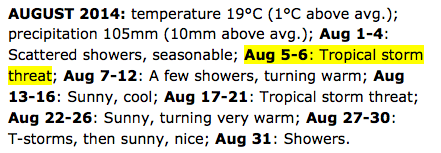
Environment Canada’s tropical cyclone information statement for today:
Bertha is now being declared a post-tropical storm. The forecast for offshore waters remains unchanged. Minimal effects for land areas except for some ocean swells.
However, although neither we nor any other forecasters have as yet gained sufficient insight into the mysteries of the universe to predict the weather with total accuracy, our results are almost always very close to our traditional claim of 80 percent.
The Guild, which is home to the Reinventorium, is also home to a black-box theatre, a theatre that happens to be located less than an arm’s length through the wall in front of my desk where I type.
This theatre plays host to a rollicking schedule of productions over the summer months, and while I’m generally happy to have my work happen in a space that oozes creativity, sometimes that oozing interferes with the quiet contemplation needed to do complex digital work.
All of which is to say: sometimes it’s hard to get work done when a troupe of fresh-faced triple threats is belting out Anne of Green Gables-themed show tunes in the room next door.
So the question then becomes: when is this happening?
The snappy new Guild website has a helpful calendar right on the front page, but the schedule information there isn’t much use to me if I’m not making a daily visit to the website: I want the information on the same day-to-day calendar that I used to manage everything else in my life, a calendar that appears on my laptop, my iPad and my phone and automatically syncs among the three.
So the question becomes: how to liberate the calendar information of of its website prison and into a shareable object?
This turned out not to be too difficult; here’s how I did it.
Look under the Hood
Firebug is a very useful tool for looking under the hood of a website: it’s like a super-charged version of “View Source.” Using Firebug’s “Network” tab, I watched as the The Guild website loaded:
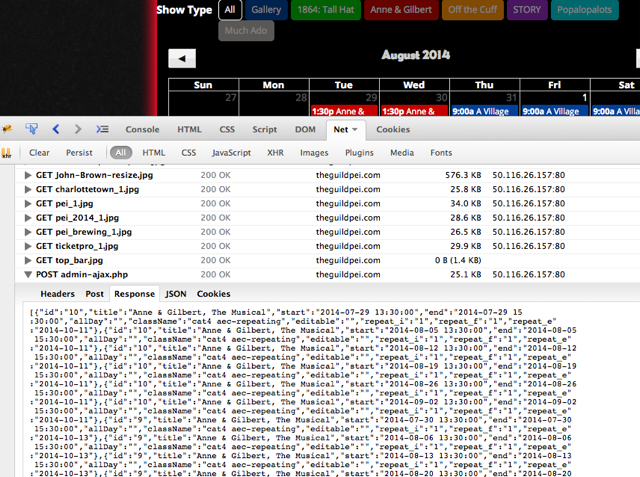
I noticed that one of the things to happen as an HTTP POST to a script called admin-ajax.php with the following parameters:
action=get_events readonly=true categories=0 excluded=0 start=1406430000 end=1410058800
The important bits here appeared to be the start and end, which were unixtime values for July 25, 2014 and September 7, 2014 respectively, which is that range of dates on this month’s calendar.
The response from this POST was a JSON-encoded array with the events taking place between these start and end dates, like this:
[
{
"id": "10",
"title": "Anne & Gilbert, The Musical",
"start": "2014-07-29 13:30:00",
"end": "2014-07-29 15:30:00",
"allDay": "",
"className": "cat4 aec-repeating",
"editable": "",
"repeat_i": "1",
"repeat_f": "1",
"repeat_e": "2014-10-11"
},
{
"id": "10",
"title": "Anne & Gilbert, The Musical",
"start": "2014-08-05 13:30:00",
"end": "2014-08-05 15:30:00",
"allDay": "",
"className": "cat4 aec-repeating",
"editable": "",
"repeat_i": "1",
"repeat_f": "1",
"repeat_e": "2014-10-11"
},
The important bits of information here were the title, the start and end date, and the “cat” in the “className” element. The “cat” was important because the calendar lists both theatre shows and art gallery shows, and I only want the theatre shows on my calendar, so I want to exclude any event with “cat1”.
Converting JSON to iCalendar
The iCalendar format is a simple, well-documented plain text format for representings events; it’s the lingua franca of calendaring apps, and you can import iCalendar files into Apple’s Calendar, into Google Calendar, and into most anything else that reads and writes event data.
To convert the JSON-encoded calendar data on The Guild website into an iCalendar-format file, I wrote a little PHP script called harvest-guild-calendar.php that uses cURL to issue the HTTP POST to The Guild website, requesting events for the next 90 days, and then parses the response and outputs each event – minus gallery shows – into a iCalendar file.
The resulting file (here’s a full snapshot taken today) looks, in part, like this:
BEGIN:VCALENDAR CALSCALE:GREGORIAN PRODID:-//Reinvented Inc.\, //TheGuild 1.1//EN X-WR-CALNAME;VALUE=TEXT:The Guild Theatre X-WR-TIMEZONE;VALUE=TEXT:Canada/Atlantic VERSION:2.0 BEGIN:VEVENT SUMMARY:Anne & Gilbert, The Musical DTSTART;TZID=Canada/Atlantic:20140805T133000 DTEND;TZID=Canada/Atlantic:20140805T153000 END:VEVENT BEGIN:VEVENT SUMMARY:Anne & Gilbert, The Musical DTSTART;TZID=Canada/Atlantic:20140812T133000 DTEND;TZID=Canada/Atlantic:20140812T153000 END:VEVENT BEGIN:VEVENT SUMMARY:Anne & Gilbert, The Musical DTSTART;TZID=Canada/Atlantic:20140819T133000 DTEND;TZID=Canada/Atlantic:20140819T153000 END:VEVENT
Spreading the Calendar
With the iCalendar file in hand, it was short work to create a shareable Google Calendar for The Guild, and to make this available in several formats:
- iCalendar (suitable for importing or subscribing to in Apple’s Calendar for OS X or iOS, etc.)
- XML (suitable for viewing in feed readers)
- HTML (standalone viewing in a browser, or embedding in another website)
Using the Calendar
In my case, I took the iCalendar-format file and imported it into my ownCloud calendar, which then automatically echoed it the Calendar on my desktop:
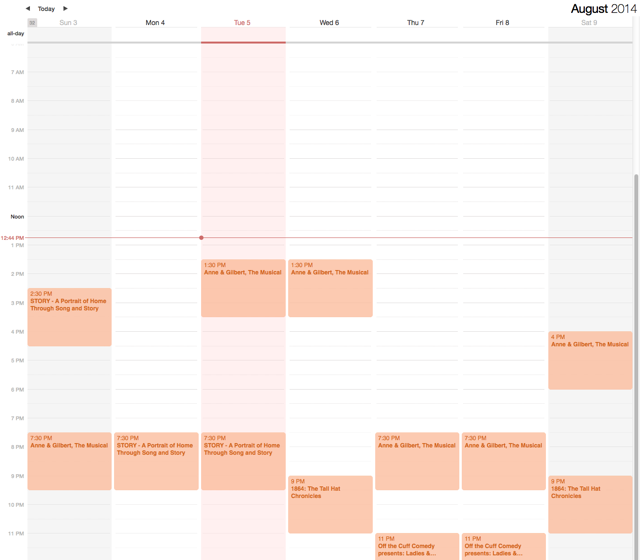
And the calendar on my Android phone:
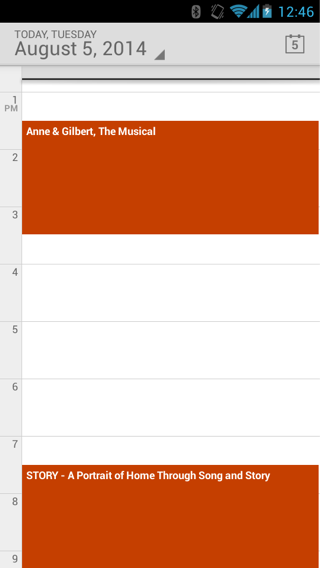
And to everywhere else I see my calendar.
As a result of all this, I have continuous awareness of when Anne & Gilbert are about to break out into song.
Like – as you can see from my phone above – in about 35 minutes from now.
Time for lunch.
Starting on January 1, 1914 and for every issue of the paper going forward, The Charlottetown Guardian ran some variation of “Confederation Celebration, Charlottetown” as part of its flag on page 1:

Until, that is, Tuesday, August 4, 1914 when it was changed to “Confederation Celebration, Postponed”:

As a page 1 story explained:
At a special meeting of the General Committee for the celebration of the Jubilee of Confederation held in the Council Chamber last night it was resolve to postpone indefinitely celebration of the event.
Hon. Mr. Justice Haszard presided over a full attendance.
The chairman opening the proceedings by referring to the crisis in Europe and asked an expression of opinion as to the advisability of proceeding with the celebration.
Hon. J. A. Mathieson, Premier, thought there was no alterative to postponement. In the present condition of affairs there was nothing else for it.
The chairman, Messrs. Pope, Tidmarsh and Ings concurred.
Mr. Pop this moved, seconded by Mr. Heartz:
“The in view of the fact that the Empire is at present engaged in a world-wide struggle and all lesser issues are sunk in our hopes and fears for the welfare of our country, it would, in the opinion of the Committee, be unfitting to hold the celebration at this time and it is therefore decided that it be postponed indefinitely, and that the Committee adjourn subject to the call of the chair.”
The following day, Wednesday, August 5, 2014, The Guardian reported that Britain had declared war:
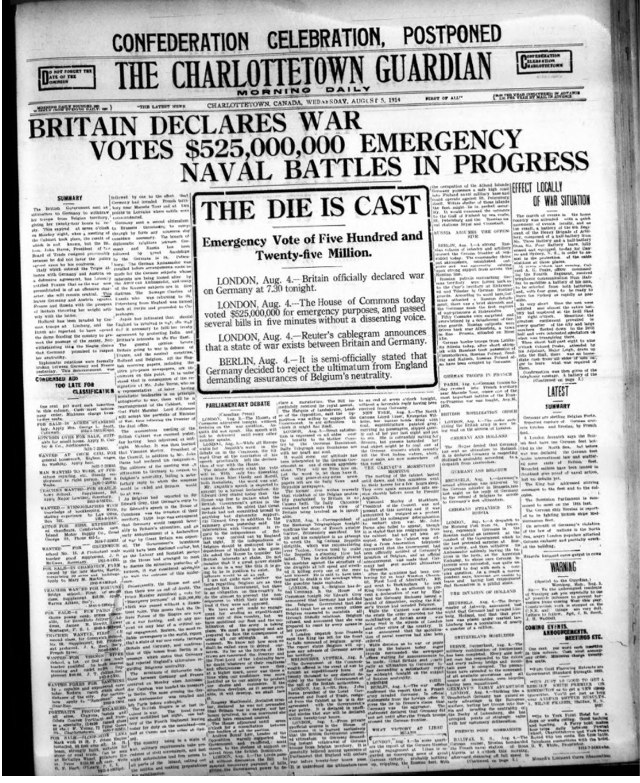
 I am
I am